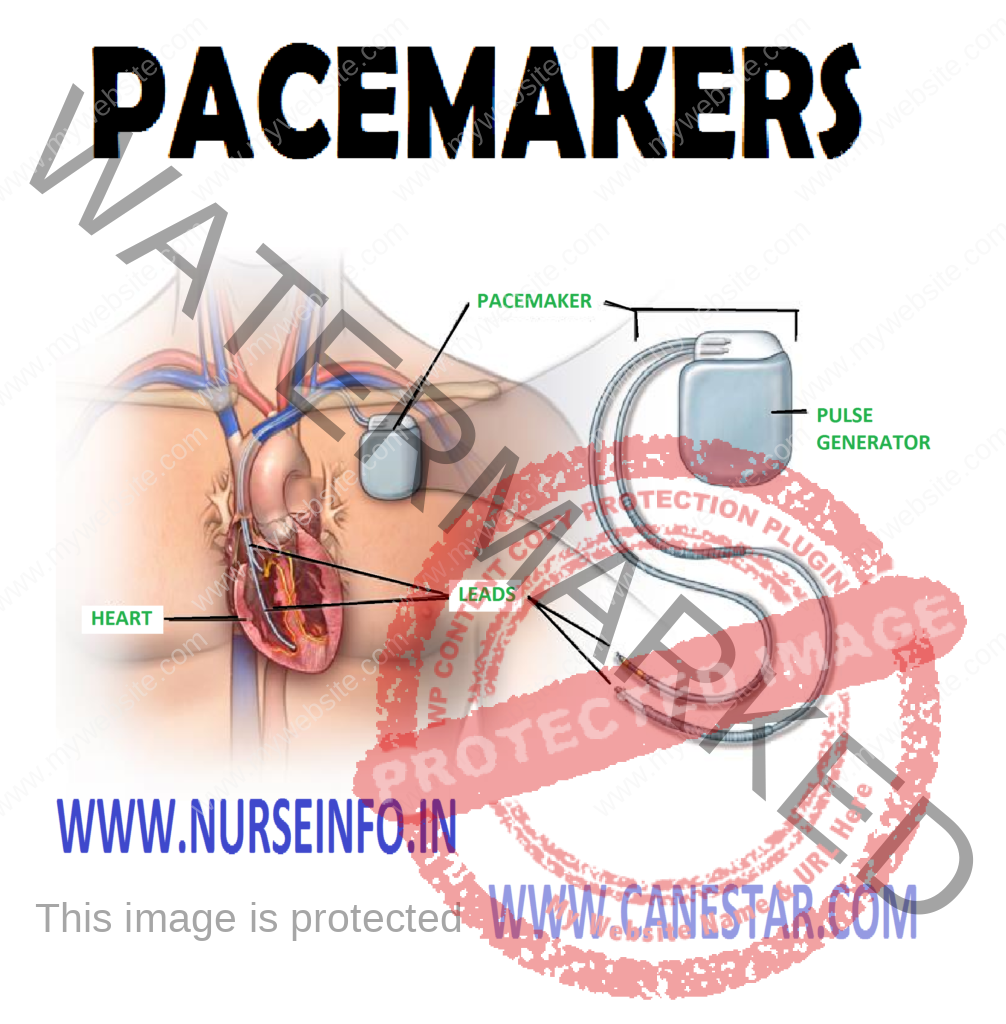PACEMAKERS – Components of Pacemakers, Indications for Artificial Pacemakers and Temporary Introduction Sites
An artificial pacemaker is a mechanical device that electronically stimulates impulse initiation within the heart. The artificial pacing system consists of a pulse generator and a pacing wire that delivers the stimulus to the heart to control rate. The pacing unit initiates and maintains the heart rate when the natural pacemakers of the heart are unable to do so. The purpose of artificial pacing is to control the heart rate.
Pacemakers are primarily used to treat cardiac defects in which the catheter is placed in the atria, ventricle or both to ensure adequate depolarization by the site of impulse blockage. These devices are also employed to remedy inadequate impulse initiation by the SA node and to suppress myocardial irritability that does not respond to antiarrhythmic therapy. In these instances, the catheter may be placed in the atrium.
COMPONENTS OF PACEMAKERS
Pulse Generator
Battery cells power pulse generator. Lithium batteries lasting 6 years or more are used in most pacemakers. Nuclear powered pacemakers (Plutonium 238 source) can last 20 years or more. Other pacemakers can have their batteries recharged; externally when the generator battery fails the implantable unit that contains the batteries must be replaced surgically.
The pulse generator has several controls. They are energy output, heart rate and pacing mode.
Energy output refers to the intensity of the electrical impulse delivered by the pulse generator to the myocardium. The amount of output is measured in milliamperes (MA). The MA setting is regulated by the physician at the time of pacemaker insertion and is set at the lowest level that will produce depolarization. A setting of 1.5 MA usually is sufficient to cause depolarization.
Heart rate: heart rate is set according to the desired therapeutic aim and the clinical condition of the patient. Heart rate is usually set at 70-80 beats/minute. If the purpose of pacemaker is to suppress dysrhythmia the rate usually is set higher often 100-120 beats/minute
Mode of Pacing
There are two modes of artificial pacing – Fixed mode and demand mode. In the fixed rate mode, the pacemaker fires electrical stimuli at a preset rate regardless of the person’s inherent rhythm. Asynchronous pacing is rarely used.
The most popular mode is demand or standby. The electrode at the tip of the pacing wires able to sense the person’s heart beats. The pacemaker produces a stimulus only when the persons own heart rate drops below the rate per minute preset on the generator by the physician.
Temporary pacemakers are limited to atrial or ventricular stimulation.
Types of Pacemakers
- Temporary pacemakers
- Permanent pacemakers
Depending on the place of action:
- Stimulation of venticules only:
QRS inhibited demand pacing
P wave triggered ventricular pacing
- Stimulation of atria only required the presence of a normal conduction system
- Stimulation of both atria and ventricles
INDICATIONS FOR ARTIFICIAL PACEMAKERS
- Adams Strokes Attack (Syncope secondary to third degree AV block)
- Third degree AV Block with slow ventricular rate
- Acute myocardial infarction with Mobitz AV block
- Right bundle branch block plus left anterior hemi block or left posterior hemi block (particularly Acute MI)
- New left bundle branch block associated with acute MI
- Symptomatic sinus bradycardia unresponsive to medical therapy
- Atrial fibrillation with slow ventricular rate in the patient who requires digitalis therapy
- Carotid sinus syncope
- Suppression of dysrhythmias (atrial or ventricular tachydysrhythmias)
- Dysrhythmias occurring during or after cardiac surgery
- Sick sinus syndrome
- Prophylaxis before surgery in patients with history of cardiac arrest or AV blocks
TEMPORARY INTRODUCTION SITES
- Subclavian vein
- Antecubital vein
- Jugular vein


